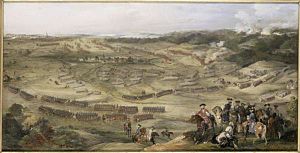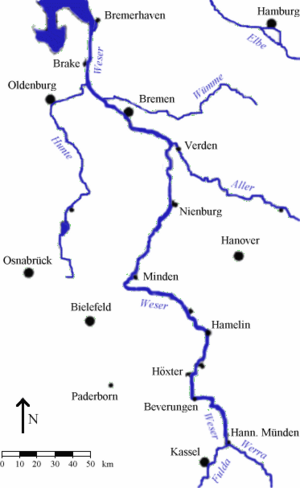Battle of Hastenbeck facts for kids
Quick facts for kids Battle of Hastenbeck |
|||||||||
|---|---|---|---|---|---|---|---|---|---|
| Part of the Seven Years' War | |||||||||
 The Battle of Hastenbeck by Louis-Edouard Rioult |
|||||||||
|
|||||||||
| Belligerents | |||||||||
| Commanders and leaders | |||||||||
| Strength | |||||||||
| 30,000 infantry, 5,000 cavalry, 28 guns |
50,000 infantry, 10,000 cavalry, 68 guns |
||||||||
| Casualties and losses | |||||||||
| 1,411 killed, wounded and missing | 1,290 killed and wounded | ||||||||
The Battle of Hastenbeck happened on July 26, 1757. It was part of the Seven Years' War, a big conflict involving many European countries. This battle took place near Hamelin in Hanover. The French army fought against soldiers from Hanover, Hesse-Kassel, and Brunswick. The French won this battle.
Contents
Why the Battle Happened: The Road to Hastenbeck
In April 1757, France sent two large armies into Germany. France was allied with countries like Austria and Russia during the Seven Years' War. Their goal was to distract Prussia, which was allied with Britain and Hanover. Prussia was busy fighting Austria in another part of Europe.
One French army, led by Prince de Soubise, marched through central Germany. This army later faced a Prussian army at the Battle of Rossbach.
The other French army was led by Marshal Louis Charles d'Estrées. It had about 50,000 foot soldiers, 10,000 horse soldiers, and 68 cannons. This army moved towards Hanover. Hanover was a region in Germany ruled by the King of Great Britain. Prussia could not send much help to Hanover. So, the job of defending Hanover fell to the "Hanoverian Army of Observation." This army was mostly made up of soldiers from Hanover (about 60%) and Hesse (about 25%). Smaller groups came from Brunswick and Prussia.
Who Led the Hanoverian Army?
The Hanoverian Army of Observation had about 30,000 foot soldiers, 5,000 horse soldiers, and 28 guns. It was led by William Augustus, Duke of Cumberland. He was a son of King George II of Great Britain.
Cumberland wanted to stop the French from taking over Hanover. He first gathered his army at Bielefeld. Then, he decided to move his troops across the Weser River, south of Minden. His plan was to use the Weser River as a natural defense. He thought it would be hard for the French to cross it. Cumberland placed most of his forces near Hamelin. He also put small patrols along the Weser.
French Movements and Crossings
While Cumberland was setting up his defenses, the French sent some soldiers north. On July 3, they captured Emden. This was an important port for Britain to reach Europe. Later, on July 15, another French group went south and took Kassel.
On the night of July 7, a strong group of French soldiers crossed the Weser River near Beverungen. Normally, the Weser River is hard to cross. But in summer, the water level drops to about 80 cm (3 feet). This makes it possible for soldiers to walk across. The French soldiers then marched north. They set up a safe crossing point at Höxter.
The main French army crossed the Weser on July 16. This left Duke Cumberland with no choice. He had to move his troops south of Hamelin to fight d'Estrées. Around this time, Frederick the Great of Prussia called back his soldiers. This happened after Prussia lost the Battle of Kolin against Austria.
The Battle of Hastenbeck
The two armies finally met on the morning of July 25 at Hastenbeck village. General François de Chevert, who led the French right side, was told to attack Hanoverian soldiers at Voremberg village. But he could not push them out. The French left side, led by General Victor-François, 2nd duc de Broglie, was still crossing the Weser. So, d'Estrées decided to wait until all his soldiers were ready.
Hanoverian Defenses
The next day, the Hanoverian army held a line from Hamelin to Voremberg. Their right side was protected by the Hamel River and Hastenbach creek. The middle of the Hanoverian army was north of Hastenbeck town. They had cannons on a high hill behind the town.
The Hanoverian left side had two cannon positions dug into the ground. Special soldier groups called grenadiers protected these cannons. The far left side was on a hill called the Obensburg. Duke Cumberland made a mistake here. He thought the hill was too hard for enemy soldiers to climb. So, he only put three small groups of Jäger (German light infantry, like hunters) on top. This left the Hanoverian left side open to attack.
French Attacks and Counterattacks
General Chevert was ordered to go around the Hanoverian position. He had four brigades (large groups of soldiers) from Picardy, la Marine, Navarre, and Eu. At 9 AM, these soldiers moved towards the Obensburg. They quickly defeated the Jäger on the hill.
Duke Cumberland saw that his army was in danger from behind. He ordered his extra soldiers and the grenadiers (who were protecting the cannons) to take back the Obensburg. Using these grenadiers for the counterattack meant they were not available in the middle of the battle. This happened just as the main French attacks began against the Hanoverian center.
The main French attack came from General d'Armentieres. He attacked Voremberg with five brigades of foot soldiers and four groups of horse soldiers who were fighting on foot. At the same time, the French center attacked the cannons just north of it. The main Hanoverian cannons managed to stop several French attacks. But eventually, the French took over the cannons.
When the Hanoverian extra soldiers arrived on the Obensburg, they managed to push back the French for a short time. But Duke Cumberland had already started to pull his army back. So, the soldiers on the Obensburg could not hold their position for long.
What Happened After the Battle
The Battle of Hastenbeck is unusual because both army commanders thought they had lost. Both were starting to pull their soldiers back from the battlefield.
The battle ended with the French winning. This led to the Convention of Klosterzeven on September 18. This agreement meant that the French would occupy Hanover. During the battle, the village of Hastenbeck was almost completely destroyed. Only the church, the manse (a church house), and one farmhouse were left standing.



